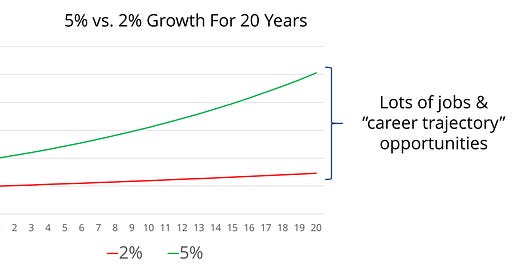May 25th, 2024: Greetings from Austin and happy MDW from the US. Today, I went back to an essay I wrote several years ago and went deeper, trying to rewrite and revisit some of the ideas. I thought you might find it interesting.
+House Swapping: I screwed up the link to Kindred last week, so if you want to check it out, here is the house-swapping network we are going to trial this summer. I have a few invites to give away (comes with 5 free nights), Join using this link
+Pathless Path Meetups: In Mexico City Meetup on June 6th and Boulder sometime in July (date TBD)
+Alternative Parenting & Education Paths Research Group: I’m spinning up a pop-up research group for parents exploring alternative paths for raising and educating kids. Sign up here.
“This person has a good career trajectory”
The idea of a good career trajectory is deeply embedded in our beliefs about how work should be. If you work hard you should be able to keep consistently climbing the ladder.
I worked in executive search for a stretch and when we looked at resumes, we always went through the same quick mental checklist. No gaps in their resume…check. A steady string of promotions…check. Good brand names…check.
For the types of positions we were hiring for, maybe it was relevant. Big companies need people dedicated to their jobs and won’t quit on a whim.
But given how few people have a perfect career trajectory, what does this select for? And what is the impact on everyone in the middle of their career? Does it keep people in a state of low-grade anxiety about their “employability” and continued ability to stay relevant?
For me, I was constantly aware that I was being judged on these terms. But I kept jumping from job to job anyway. I was searching for something I couldn’t quite understand.
But I knew my approach was hurting my potential to rise in most organizations..
The idea of a steady career trajectory is a byproduct of a special moment in history called the “long boom”
After World War II, the US dictated the rules of the global economy, ensuring their companies and institutions would be winners.
Estimates during the 1950s and 1960s estimate that average growth rates were 4-5% annually. Outside of the last couple of years, which have been high but also impacted by inflation and stimulus, the last few decades have been closer to 2% close.
The difference is massive.
Let’s look at the difference in compounding over 20 years comparing 5% to 2%:
The 20+ years period after World War II is now called “The Long Boom” or sometimes the “Golden Age of Capitalism.” It combined a constant labor participation rate with a massive boom in economic growth.
William Whyte wrote this in The Organization Man in 1956:
The prosperity of recent years has had a lot to do with the rosiness of the view. Corporations have been expanding at a great rate, and the effect has been a large-scale deferral of dead ends and pigeonholes for thousands of organization men. With so many new departments, divisions, and plants being opened up, many a young man of average ability has been propelled upward so early—and so pleasantly—that he can hardly be blamed if he thinks the momentum is a constant.
It was in this period that the “steady career path” was born.
Donald Super & The Career Path of the 1950s
In researching career paths, I came across a career development “theory” created by the American psychologist Donald Super.
It focused on five key stages that one goes through in life. Being the 1950s, it focused mostly on men:
growth – preparation for work (ages 0–14)
exploration – trying out different work options (ages 15–24)
establishment – choosing and progressing in a career (ages 25–44)
maintenance – continuing your chosen career (ages 45–64)
decline – retirement (ages 65+).
This feels quite narrow and limiting in today’s context.
Pick something by 25? Just getting done with school?
Fully establish yourself by 44? What about layoffs? Industry disruption?
Maintenance? You can finally explore things out of work at 44
In that era, the modern organization-based career was just getting started. They didn’t foresee that company loyalty would eventually disappear, or more importantly, how much shorter the average firm lifespan would be.
The interesting thing was that Super kept going with these ideas until late in life. At 79 years old, in 1990, he proposed a much broader lifespan theory embracing what he called a “life career.” It’s quite confusing but still seems quite a simplistic view of life.
I talked a lot about how our embedded cultural scripts shape our expectations for life in The Pathless Path. And Super seemed to be capturing this above. There are single decision points at specific ages where you are supposed to figure things out. But as everyone knows, things rarely go this smoothly. The boomer generation may have been the last generation to truly be able to start and end a career with a single company and even then, it probably wasn’t the norm.
And his “career rainbow” with the following graphic still embracing the same life phases:
At least 40 years later he gives more credit to external circumstances, writing, “But the individual pursuing the career may be viewed as being at the center of the scene, with the situation around lifting him or pressing down upon him.”
We have yet to move on from these broken assumptions
We still operate with the assumptions that were cemented during this time. And you can still find it shaping reality most strongly in big corporations, law firms, consulting firms, and other service firms.
To hide the fact that promotions are no longer guaranteed, companies have developed “alternative” paths. Academia now has adjunct professors:
Consulting firms have “experts” instead of partners, and law firms have “non-equity partners.”
Even within the traditional path, there are now many more steps than there were in this period. Having worked in the consulting industry and studied the history of these types of firms, here is the difference in the paths:
For people still want the promised path? One lawyer described the process of becoming a partner as “no harder than living inside a tankful of hungry sharks.” Sign me up!
Corporations, like law firms, are performing the same song and dance. To become CFO you are an analyst, then a senior analyst, a lead analyst, then a senior lead analyst, and well, you get the idea.
Here’s how Jim O’Shaughnessy described all of this, another quote from my book
We made a mistake and by that I mean my generation and my parents generation. The mistake we made was thinking that the period from 1946 to 1980 was the norm. No it was not! It was the anomaly! We had just wiped out the manufacturing capabilities of anyone who could challenge us. So the idea that you had that job with the gold watch and you could work there for your entire career and raise a family of four and all of that, that was an anomaly. In the late 1950s Detroit was selling 80%+ of all autos sold in the world.
Hey! Thanks for reading…
I am not sure how you ended up here but might have stumbled upon me through my writing or podcasting on our relationship to work, a topic that has interested me for years.
If you don’t enjoy the writing, I strongly encourage you to unsubscribe below. There’s so much good stuff on the internet!! A reminder: I don’t check unsubscribe alerts and never look at my subscriber list. So if you feel like unsubscribing, you can do so below.
But if you do want to stick around:
If you’d like to meet others on “pathless paths”, you can join The Pathless Path Community
Buy or listen to my book, The Pathless Path. If you’d like to do a bulk order you can do that here for a discount.
You can buy pathless path swag like a hat or shirt here
Subscribe to my podcast and leave a review.
Home Swapping: We’ll likely be using Kindred a bit this summer. It’s a pretty cool home-swapping alternative to Airbnb. If you want to join, use my signup code.
5.5% Savings: Use this link to get 5.5% on your savings on Wealthfront and increase your runway on your pathless path
Affiliates: In addition, I recommend all of the following services: Ali Abdaal’s YouTube Course, Collective for setting up an S-Corp in the US (recommended >$60k revenue), Riverside.fm for HD podcasting, Descript for text-based video editing, Transistor for podcast hosting, Podia or Teachable for courses, Skystra for WordPress Hosting, and Circle for running a community.
Submissions: Want to share your journey with my audience? I accept drafts for submission.

























We claim we care about diversity… except when it comes to how to work.
To use a religious analogy…
Many people are stuck believing in “Work Monism,” aka the idea there is ONE BEST WAY for everyone to work (from hours, to location, until a certain age, etc.). They preach and force this belief on others. And these beliefs are reinforced in our policy and systems (e.g. employer based health insurance).
Instead, we are clearly now living in a world of “Work Pluralism” where there are MANY different ways of work. There is no one way that fits all people and all contexts.
Embracing this reality would save many of us a lot of pain and disappointment.
I saw someone on Substack write about a “portfolio career” and I thought that was an interesting concept I hadn’t heard of before.
I am starting my sabbatical on Friday and reading about these traditional paths are making the rebel in me get really excited 😊